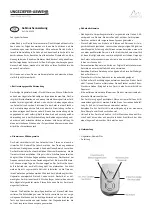
15
■
lower left LED (MAKE UP ROOM):
- Off if input I5 is not active.
- On at set brightness for standby if I5 is active.
■
upper central LED: always off.
■
lower central LED (door bell):
- Off if input I6 is active (DO NOT DISTURB).
- On at set brightness for standby if I6 is not active.
■
upper right LED (OUT = client out of room):
- Off if input I2 is not active.
- On at set brightness for standby if I2 is active.
■
lower right LED (DO NOT DISTURB):
- Off if input I6 is not active.
- On at set brightness for standby if I6 is active.
■
If a hand enters the proximity detection area, the device will be activated.
6.2.1 Activated
The colour and brightness of the LEDs is that set during configuration.
■
upper left LED (IN = client in room):
- Off if input I1 is not active.
- On at full brightness if I1 is active.
■
lower left LED (MAKE UP ROOM):
- Off if input I5 is not active.
- On at full brightness if I5 is active.
■
upper central LED: always off.
■
lower central LED (door bell):
- Off if input I6 is active (DO NOT DISTURB).
- On at full brightness if I6 is not active.
■
upper right LED (OUT = client out of room):
- Off if input I2 is not active.
- On at full brightness if I2 is active.
■
lower right LED (DO NOT DISTURB):
- Off if input I6 is not active.
- On at full brightness if I6 is active.
■
10 s after the hand is withdrawn from the proximity area, the device returns to standby.
Note:
The only push button used in the lower central one (door bell). Pressing this push button (touch or physical), the device will activate output O4 for as long
as the button is pressed; if the DO NOT DISTURB signal is enabled (I6 active) output O4 is disabled.
7. Installation rules
Installation should be carried out by qualified personnel in compliance with the current regulations regarding the installation of electrical equipment in the country where the
products are installed.
8. Regulatory compliance
EMC Directive.
Standard EN 60669-2-1.
Installation rules - Regulatory compliance
WEEE - Information for users
If the crossed-out bin symbol appears on the equipment or packaging, this means the product must not be included with other general waste at the end of its working life. The user must take the worn
product to a sorted waste center, or return it to the retailer when purchasing a new one. Products for disposal can be consigned free of charge (without any new purchase obligation) to retailers with a
sales area of at least 400 m
2
, if they measure less than 25 cm. An efficient sorted waste collection for the environmentally friendly disposal of the used device, or its subsequent recycling, helps avoid the
potential negative effects on the environment and people’s health, and encourages the re-use and/or recycling of the construction materials.


































